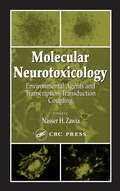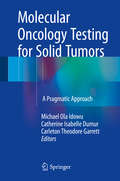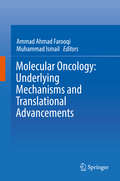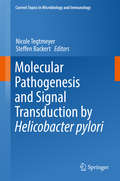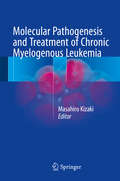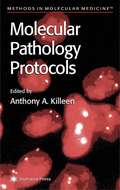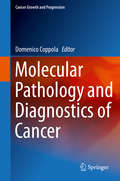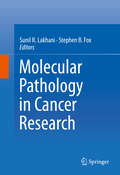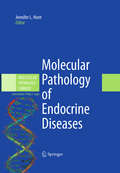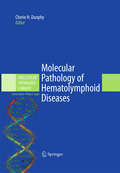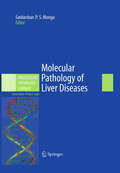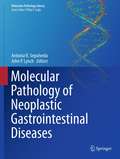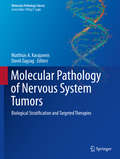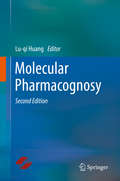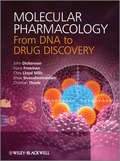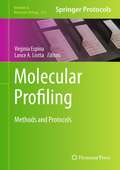- Table View
- List View
Molecular Neurotoxicology: Environmental Agents and Transcription-Transduction Coupling
by Nasser H. ZawiaMolecular Neurotoxicology: Environmental Agents and Transcription-Transduction Coupling deals with changes in gene expression following exposure to neurotoxicants, as well as deciphering signal transduction or transcription coupling that is altered by the same exposure. Until now, little has been published on the topic in one reference, and toxicol
Molecular Oncology Testing for Solid Tumors
by Michael Ola Idowu Catherine Isabelle Dumur Carleton Theodore GarrettFamiliarity with and understanding molecular testing is becoming imperative for practicing physicians, especially pathologists and oncologists given the current explosion of molecular tests for diagnostic, prognostic and predictive indications. Molecular Oncology Testing for Solid Tumors is designed to present an up to date practical approach to molecular testing in a easy to understand format. Emphasis is placed on quality assurance (pre-analytic, analytic and post-analytic) and test interpretation, including but not limited to: the important role of pathologists in ensuring specimen adequacy for molecular testing; factors to consider in choosing platforms for molecular assays; advantages and limitations inherent to common assays/platforms that pathologists need to communicate effectively with clinicians; the importance of required quality assurance measures to ensure accurate / reproducible results; pitfalls in test interpretation (including different types of artifacts that may lead to False Positive or False Negative interpretations); test reporting using standard nomenclature; review of the current and future potential utility of next-generation sequencing in oncology. All chapters are written by pathologists and clinicians experienced in practical applications of molecular tests for solid tumors. The uniqueness of this textbook is the use of a standardized template for each of the molecular tests being discussed followed by a discussion of relevant quality assurance issues to ensure focused and efficient presentation of information. This will enable readers to easily understand the Order, Report and Evaluate (ORE) process of molecular tests. Lastly, summary tables of all the molecular assays and mutations discussed in the text are provided as an appendix for quick reference. For readers interested in more detailed information, a link to websites where additional information can be obtained is provided.
Molecular Oncology: Underlying Mechanisms and Translational Advancements
by Muhammad Ismail Ammad Ahmad FarooqiCancer is a multifaceted and genomically complex disease and data obtained through high throughput technologies has provided near complete resolution of the landscape of how genomic, genetic and epigenetic mutations in cancerous cells effectively influence homeostasis of signaling networks within these cells, between cancerous cells, tumor microenvironment and at the organ level. Increasingly sophisticated information has helped us in developing a better understanding of the underlying mechanisms of cancer, and it is now known that intra-tumor genetic heterogeneity, cellular plasticity, dysregulation of spatio-temporally controlled signaling cascades, and loss of apoptosis are contributory in cancer development, progression and the development of resistance against different therapeutics. It is becoming progressively more understandable that earlier detection of pre-existing or emerging resistance against different therapeutics may prove to be helpful in personalizing the use of targeted cancer therapy. Despite the fact that there is a continuously increasing list of books, being guest edited by researchers, books on the subject are often composed of invited reviews without proper sequence and continuity and designed for a particular readership. This book progressively shifts and guides the readers from basic underlying mechanisms to translational approaches to treat cancer.
Molecular Pathogenesis and Signal Transduction by Helicobacter pylori
by Steffen Backert Nicole TegtmeyerThis volume reviews the current state of research concerning bacterial virulence factors and the infection biology of Helicobacter pylori, which is the leading cause of peptic ulcers and gastric cancer worldwide. The chapters include cutting-edge findings on this fascinating microbe and discuss the general strategies of H. pylori infection and persistence, news on important H. pylori virulence factors, crosstalk with the microbiota, hot novel models and signaling mechanisms, risk factors of gastric disease and stomach cancer, and the impact of H. pylori infection on non-gastric diseases. Written by internationally respected scientists, this book will appeal to clinicians, researchers and advanced students alike.
Molecular Pathogenesis and Treatment of Chronic Myelogenous Leukemia
by Masahiro KizakiCovering the history of breast cancer, theory of radiofrequency ablation (RFA), resection of carcinoma, imaging before and after non-surgical ablation therapy and quality of life, this book focuses on extensive breast-conserving treatment for the preservation of a cosmetically acceptable breast. It investigates the feasibility of percutaneous, minimally invasive techniques to ablate breast tumors and several modalities such as cryosurgery, laser ablation, thermoablation and high-intensity focused ultrasound. Non-surgical Ablation Therapy for Early-stage Breast Cancer centers on RFA and provides insights into cryoablation and focused ultrasound surgery. RFA has been shown to be effective for treating tumors in many types of tissue, including liver, bone, brain, kidney, pancreas and prostate. As such this book is a valuable resource for breast and general surgeons, radiation oncologists and medical oncologists in all areas. The extensive discussions enable scholars to gain radiological expertise and a basic understanding of molecular biology, leading to better surgery without scalpels.
Molecular Pathogenesis of Colorectal Cancer
by Kevin M. HaigisColorectal cancer has for more than two decades served as the paradigm for the multi-step concept of cancer initiation and progression. Perhaps more than any other organ site, cancer of the colon is extensively characterized at the molecular level. We are now entering a time when molecular classification, rather than histologic classification, of cancer subtypes is driving the development of clinical trials with emerging targeted therapies. The book will focus on the progression from the identification of mutations that drive colorectal cancer initiation and progression to the search for novel therapies to treat the disease.
Molecular Pathology Protocols
by Anthony A. KilleenAnthony Killeen has assembled a collection of readily reproducible molecular pathology techniques that are either frequently performed or recognized for their significant diagnostic utility. Each method is described in step-by-step detail by a leading molecular pathologist or laboratory scientist who has developed it or used it extensively. These clinical laboratory techniques can be used for the diagnosis or monitoring of cancer, hematological malignancies, infectious diseases, and selected genetic disorders. Comprehensive and path-breaking, Molecular Pathology Protocols will enable clinical laboratories to introduce new molecular pathology tests and lay the groundwork for a much-needed standardization in this rapidly developing field.
Molecular Pathology and Diagnostics of Cancer
by Domenico CoppolaMolecular pathology is based on the emergence of new techniques that greatly enhance the diagnostic accuracy when facing with challenging differential diagnoses. In addition, new molecular techniques are entering the clinical arena for their value in predicting therapy response and tumor prognosis. This book provides a guide for the practicing pathologist and for both pathology residents and fellows during the daily sign-out of challenging cases. The book is organized by anatomical systems and provides a detailed description of molecular tests that may help in the diagnosis. Furthermore, a description of the current molecular tests required to identify patients for treatment is offered. The application of molecular pathology techniques to the clinical practice has already shown its usefulness and the number of such tests is growing exponentially as more molecular targets are discovered. Molecular Pathology and Diagnostics of Cancer will give practicing and training pathologists an up-to date resource to guide the correct management of pathology cases requiring molecular testing.
Molecular Pathology in Cancer Research
by Sunil R. Lakhani Stephen B. FoxThe aim of the book is to discuss the application of molecular pathology in cancer research, and its contribution in the classification of different tumors and identification of potential molecular targets, as well as how this knowledge may be translated into clinical practice, and the huge impact this field is likely to have in the next 5 to 10 years.
Molecular Pathology in Clinical Practice
by Debra G.B. LeonardThis authoritative textbook offers in-depth coverage of all aspects of molecular pathology practice and embodies the current standard in molecular testing. Since the successful first edition, new sections have been added on pharmacogenetics and genomics, while other sections have been revised and updated to reflect the rapid advances in the field. The result is a superb reference that encompasses molecular biology basics, genetics, inherited cancers, solid tumors, neoplastic hematopathology, infectious diseases, identity testing, HLA typing, laboratory management, genomics and proteomics. Throughout the text, emphasis is placed on the molecular variations being detected, the clinical usefulness of the tests and important clinical and laboratory issues. The second edition of Molecular Pathology in Clinical Practice will be an invaluable source of information for all practicing molecular pathologists and will also be of utility for other pathologists, clinical colleagues and trainees.
Molecular Pathology of Breast Cancer
by Sunil Badve Yesim Gökmen-PolarThe complex landscape of breast cancer requires distinct strategies for the management of various molecular subtypes of this disease. Rapid advances in the field of molecular biology have been bewildering for those involved in its study and management. "Molecular Pathology of Breast Cancer" aims to close this knowledge gap by discussing comprehensively the evolution, biological basis and clinical applications with a focus on the "what, when, and how" of the most significant molecular markers known to date. These markers are evaluated in the context of genomic, transcriptomic and proteomic profiles, which is integral to the practice of precision medicine. The application of next generation sequencing (NGS) has provided new insights in the regulation of genomic and transcriptomic structure and function. Alterations in DNA such as mutations and single nucleotide polymorphisms (SNPs) have been correlated with outcomes and provide for novel therapeutic approaches. These NGS analyses have also revealed the extensive contributions of epigenetic mechanisms such as histone modifications, non-coding RNA and alternative splicing. All of these changes together contribute to alterations in proteome. Newer assays that allow greater stability and analytical consistency are emerging. These alterations in tumor profiles can be also now detected by imaging techniques. The heterogeneity of both tumor and tumor microenvironment, an inevitable reality, is discussed in detail with particular focus on cancer stem cells and immune signaling. A chapter is dedicated to the emerging technology of "liquid biopsy", which opens a novel approach for "continuous" monitoring of cancer that might be superior to conventional diagnostics, "Molecular Pathology of Breast Cancer" provides a quick and easy, not to mention essential, tour for clinicians, pathologists and scientists who are seeking to understand the integration of molecular biology into the diagnosis, prognosis and management of breast cancer.
Molecular Pathology of Endocrine Diseases
by Philip T. Cagle Jennifer L. HuntThe past two decades have seen an ever-accelerating growth in knowledge about molecular pathology of human diseases which received a large boost with the sequencing of the human genome in 2003. Molecular diagnostics, molecular targeted therapy and genetic therapy are now routine in many medical centers. The molecular field now impacts every field in medicine, whether clinical research or routine patient care. There is a great need for basic researchers to understand the potential clinical implications of their research whereas private practice clinicians of all types (general internal medicine and internal medicine specialists, medical oncologists, radiation oncologists, surgeons, pediatricians, family practice), clinical investigators, pathologists and medical laboratory directors and radiologists require a basic understanding of the fundamentals of molecular pathogenesis, diagnosis and treatment for their patients. Traditional textbooks in molecular biology deal with basic science and are not readily applicable to the medical setting. Most medical textbooks that include a mention of molecular pathology in the clinical setting are limited in scope and assume that the reader already has a working knowledge of the basic science of molecular biology. Other texts emphasize technology and testing procedures without integrating the clinical perspective. There is an urgent need for a text that fills the gap between basic science books and clinical practice. In the Molecular Pathology Library series the basic science and the technology is integrated with the medical perspective and clinical application. Each book in the series is divided according to neoplastic and non-neoplastic diseases for each of the organ systems traditionally associated with medical subspecialties. Each book in the series is organized to provide (1) a succinct background of the essential terminology, concepts and technology of molecular biology, (2) an overview of the broad application of molecular biology principles to disease and (3) specific application of molecular pathology to the pathogenesis, diagnosis and treatment of neoplastic and non-neoplastic diseases specific to each organ system. These broad section topics will be broken down into succinct chapters, averaging about 15 to 20 pages each, to cover a very specific disease entity. The chapters will be written by established authorities on the specific topic from academic centers around the world. In one book, diverse subjects are included that the reader would have to pursue from multiple sources in order to have a clear understanding of the molecular pathogenesis, diagnosis and treatment of specific diseases. Attempting to hunt for the full information from basic concept to specific applications for a disease from the varied sources is time-consuming and frustrating. By providing this quick and user-friendly reference, understanding and application of this rapidly growing field is made more accessible to both expert and generalist alike. As books that bridge the gap between basic science and clinical understanding and practice, the Molecular Pathology Series serves the basic scientist, the clinical researcher and the practicing physician or other health care provider who require more understanding of the application of basic research to patient care, from "bench to bedside." This series is unique and an invaluable resource. These books will be indispensable to physicians and health care providers in multiple disciplines as noted above, to residents and fellows in these multiple disciplines as well as their teaching institutions and to researchers who increasingly must justify the clinical implications of their research.
Molecular Pathology of Hematolymphoid Diseases
by Philip T. Cagle Cherie H. DunphyThe past two decades have seen an ever-accelerating growth in knowledge about molecular pathology of human diseases which received a large boost with the sequencing of the human genome in 2003. Molecular diagnostics, molecular targeted therapy and genetic therapy are now routine in many medical centers. The molecular field now impacts every field in medicine, whether clinical research or routine patient care. There is a great need for basic researchers to understand the potential clinical implications of their research whereas private practice clinicians of all types (general internal medicine and internal medicine specialists, medical oncologists, radiation oncologists, surgeons, pediatricians, family practitioners), clinical investigators, pathologists and medical laboratory directors and radiologists require a basic understanding of the fundamentals of molecular pathogenesis, diagnosis and treatment for their patients. Traditional textbooks in molecular biology deal with basic science and are not readily applicable to the medical setting. Most medical textbooks that include a mention of molecular pathology in the clinical setting are limited in scope and assume that the reader already has a working knowledge of the basic science of molecular biology. Other texts emphasize technology and testing procedures without integrating the clinical perspective. There is an urgent need for a text that fills the gap between basic science books and clinical practice. In the Molecular Pathology Library series the basic science and the technology is integrated with the medical perspective and clinical application. Each book in the series is divided according to neoplastic and non-neoplastic diseases for each of the organ systems traditionally associated with medical subspecialties. Each book in the series is organized to provide specific application of molecular pathology to the pathogenesis, diagnosis and treatment of neoplastic and non-neoplastic diseases specific to each organ system. These broad section topics are broken down into succinct chaptersto cover a very specific disease entity. The chapters are written by established authorities on the specific topic from academic centers around the world. In one book, diverse subjects are included that the reader would have to pursue from multiple sources in order to have a clear understanding of the molecular pathogenesis, diagnosis and treatment of specific diseases. Attempting to hunt for the full information from basic concept to specific applications for a disease from varied sources is time-consuming and frustrating. By providing this quick and user-friendly reference, understanding and application of this rapidly growing field is made more accessible to both expert and generalist alike. As books that bridge the gap between basic science and clinical understanding and practice, the Molecular Pathology Series serves the basic scientist, the clinical researcher and the practicing physician or other health care provider who require more understanding of the application of basic research to patient care, from "bench to bedside." This series is unique and an invaluable resource to those who need to know about molecular pathology from a clinical, disease-oriented perspective. These books will be indispensable to physicians and health care providers in multiple disciplines as noted above, to residents and fellows in these multiple disciplines as well as their teaching institutions and to researchers who increasingly must justify the clinical implications of their research.
Molecular Pathology of Liver Diseases
by Philip T. Cagle Satdarshan P. MongaCellular and Molecular Pathology of the Liver is extensive, complex and ranges from the understanding the basic molecular mechanisms that dictate everything from liver homeostasis to liver disease. Molecular Pathology of the liver is complicated due to some of the important functions inherent and unique to the Liver, including its innate ability to regenerate and the multitude of functions it plays for the wellbeing of an organism. With all this in mind, Molecular Pathology of Liver Diseases is organized in different sections, which will coherently and cohesively present the molecular basis of hepatic physiology and pathology. The first two sections are key to understanding the liver anatomy and physiology at a cellular level and go on to define the molecular mechanics in various liver cell types. These sections also cover the existing paradigms in liver development, regeneration and growth. The next section is key to understanding the Molecular Pathology unique to liver diseases and associated phenotypes. The final sections are geared towards the existing knowledge of the molecular basis of many common and uncommon liver diseases in both neoplastic and non-neoplastic areas including pathologies associated with intra-hepatic and extra-hepatic biliary tree. Thus, this textbook is a one-stop reference for comprehending the molecular mechanisms of hepatic pathobiology. It is clearly unique in its format, readability and information and thus will be an asset to many in the field of Pathology and other disciplines.
Molecular Pathology of Lung Cancer
by Philip T. Cagle Timothy Craig Allen Mary Beth Beasley Alain C. Borczuk Lucian R. Chirieac Keith M. Kerr Sanja DacicAs with other books in the Molecular Pathology Library Series, Molecular Pathology of Lung Cancer bridges the gap between the molecular specialist and the clinical practitioner, including the surgical pathologist who now has a key role in decisions regarding molecular targeted therapy for lung cancer. Molecular Pathology of Lung Cancer provides the latest information and current insights into the molecular basis for lung cancer, including precursor and preinvasive lesions, molecular diagnosis, molecular targeted therapy, molecular prognosis, molecular radiology and related fields for lung cancer generally and for the specific cell types. As many fundamental concepts about lung cancer have undergone revision in only the past few years, this book will likely be the first to comprehensively cover the new molecular pathology of lung cancer. It provides a foundation in this field for pathologists, medical oncologists, radiation oncologists, thoracic surgeons, thoracic radiologists and their trainees, physician assistants, and nursing staff.
Molecular Pathology of Neoplastic Gastrointestinal Diseases
by Antonia R. Sepulveda John P. LynchMolecular Pathology of Neoplastic Gastrointestinal Diseases reviews the molecular aspects that characterize the spectrum of neoplastic conditions that affect the gastrointestinal tract, providing the reader with current up-to-date knowledge. For each disease entity chapters provide reviews on: the molecular basis of the individual diseasemolecular testing approaches currently available or in development for diagnosis or for gene target characterization for selective targeted therapiesrecommended guidelines for clinical application of molecular tests are included whenever availablemolecular testing for hereditary predisposition or disease riskanimal models and cell culture models of disease
Molecular Pathology of Nervous System Tumors
by Matthias A. Karajannis David ZagzagThis book serves as a comprehensive guide to the rapidly evolving field of molecular neuropathology of nervous system tumors, as well as the underlying biology and emerging molecular targeted therapies. Special emphasis is given to already established and emerging molecular diagnostic tests in neuropathology, as well as molecular targeted therapies. The book is organized by clinico-pathologic disease entities, and each chapter is written by a team of experts in their field. Molecular Pathology of Nervous System Tumors is of great value and utility for physicians and scientists involved with or interested in the up-to-date diagnosis and treatment of patients with brain tumors.
Molecular Pathology of the Prions
by Harry F. BakerInternationally recognized investigators review the latest developments in, and novel approaches to, understanding the prion protein and prion diseases at the molecular level. Utilizing a variety of cutting-edge techniques, these distinguished scientists seek to define the normal function of a prion protein, to detect and measure the early immune response to prion disease, and to discover possible therapeutic targets. They also use transgenic mice and new electrophysiological investigations to elucidate the pathogenetic mechanisms involved in prion diseases. State-of-the-art and richly insightful, Molecular Pathology of the Prions captures for basic and clinical neuropathologists the latest developments and approaches to understanding the pathogenesis of prion diseases, and by analogy suggests possible research techniques for the more common proteinopthies, such as Alzheimer's and Parkinson's diseases.
Molecular Pathology: A Primer for Laboratory Scientists
by Andrew BlannComprehensive textbook on molecular pathology for newcomers to the field, covering history, analytics, types of cancers, and more Molecular Pathology delivers an in-depth outline of molecular pathology appropriate for the undergraduate, postgraduate, or early-stage career lab scientist, drawing from authoritative sources such as NICE, the World Health Organisation, the Office of National Statistics, clinical guidelines, research publications and the National Genomic Test Directory. The text contains numerous tables, diagrams, and photos in each chapter to help elucidate key concepts. The opening chapter provides a general introduction to the subject with a historical perspective of key findings that have led to our current view of molecular pathology. The introduction is followed by a look at the scope of chromosomal disease (such as Down’s syndrome) and genetic disease (such as sickle cell disease). Chapter two describes the numerous analytical tools required in molecular pathology, and how complex genetic data is interpreted – i.e., bioinformatics. The remaining three chapters review the molecular pathology of focused groups of disease, including solid tumor cancer, blood cancer, and metabolic and other genetic diseases. Each of these three chapters explains the role of molecular pathology in the etiology, diagnosis, and management of each particular condition. Sample topics explored in Molecular Pathology include: Generating DNA and RNA for analysis, amplification by PCR, and DNA sequencing through micro-arrays, libraries, and Next Generation SequencingChromosome structure, covering histones and the centromere, abnormal chromosome numbers, and errors within chromosomes such as translocations and deletionsMyelofibrosis, myelodysplasia, essential thrombocythemia, polycythaemia, leukemia, lymphoma, myeloma, and haemopoiesis and maturation arrestMolecular pathology of single organ/organ system disease, such as Huntington’s and cardiomyopathy, and multi-organ disease such as Barth syndrome Molecular Pathology serves as an excellent introduction to the subject for first to third year undergraduate students. Healthcare professionals and biomedical scientists and researchers will also find it valuable.
Molecular Pathomechanisms and New Trends in Drug Research
by György Kéri István TothKnowledge of the basic mechanisms of human disease is essential for any student or professional engaged in drug research and development. Functional gene analysis (genomics), protein analysis (proteomics), and other molecular biological techniques have made it possible to understand these cellular processes, opening up exciting opportunities for no
Molecular Pharmacognosy
by Lu-Qi Huang"Molecular Pharmacognosy" discusses the application of molecular biology in resource science and authentication of traditional Chinese medicine (TCM). This book reviews the latest developments in pharmacognosy, introduces a series of new views and insights, presents the hotspots and focus of the field of study on molecular pharmacognosy, and predicts a new direction of study on the resource science of TCM. Furthermore, the book also provides an open communications platform for the development of molecular pharmacognosy. This book is intended for biomedical scientists and researchers in the fields of molecular biology, traditional medicine and natural pharmaceutics. Professor Lu-qi Huang is Director of the Collaborating Centre of the World Health Organization for Traditional Medicine (Chinese Materia Medica) and Vice-Chairman of the Australia Chinese Association for Biomedical Sciences Inc.
Molecular Pharmacognosy
by Lu-Qi HuangThis book discusses the application of molecular biology in resource science and authentication of traditional Chinese medicine (TCM). It also reviews the latest developments in pharmacognosy, introduces new perspectives and insights, discusses the hotspots and focuses in the field of molecular pharmacognosy, and predicts new directions of study. In the last five years, the technologies and scope of molecular pharmacognosy have constantly expanded and evolved. As such, this new edition includes extra content, such as the molecular phylogeography of medicinal plants, functional genome of medicinal plants, and synthetic biology of active compounds. Elucidating the concept, theory, and methodology of molecular pharmacognosy, it promotes the full use of the newly developed technologies and methodologies within the framework of molecular pharmacognosy to solve problems in the field.
Molecular Pharmacology
by Chris Lloyd Mills John Dickenson Shiva Sivasubramaniam Fiona Freeman Christian ThodeThis textbook provides a fresh, comprehensive and accessible introduction to the rapidly expanding field of molecular pharmacology. Adopting a drug target-based, rather than the traditional organ/system based, approach this innovative guide reflects the current advances and research trend towards molecular based drug design, derived from a detailed understanding of chemical responses in the body. Drugs are then tailored to fit a treatment profile, rather than the traditional method of 'trial and error' drug discovery which focuses on testing chemicals on animals or cell cultures and matching their effects to treatments. Providing an invaluable resource for advanced under-graduate and MSc/PhD students, new researchers to the field and practitioners for continuing professional development, Molecular Pharmacology explores; recent advances and developments in the four major human drug target families (G-protein coupled receptors, ion channels, nuclear receptors and transporters), cloning of drug targets, transgenic animal technology, gene therapy, pharmacogenomics and looks at the role of calcium in the cell. Current - focuses on cutting edge techniques and approaches, including new methods to quantify biological activities in different systems and ways to interpret and understand pharmacological data.Cutting Edge - highlights advances in pharmacogenomics and explores how an individual's genetic makeup influences their response to therapeutic drugs and the potential for harmful side effects.Applied - includes numerous, real-world examples and a detailed case-study based chapter which looks at current and possible future treatment strategies for cystic fibrosis. This case study considers the relative merits of both drug therapy for specific classes of mutation and gene therapy to correct the underlying defect.Accessible - contains a comprehensive glossary, suggestions for further reading at the end of each chapter and an associated website that provides a complete set of figures from within the book.A companion website with additional resources is available at www.wiley.com/go/dickenson/dnamolecular
Molecular Physiology and Evolution of Insect Digestive Systems (Entomology in Focus #7)
by Walter R. Terra Clelia Ferreira Carlos P. SilvaThis book provides a unique blend of data on insect life spans, physiology, enzymology and other molecular features associated with digestion and nutrient absorption to enrich the knowledge on insects and to disclose putative molecular targets for the development of new insect control technologies and for improving insect raising procedures to be used as food and feed. With this aim, the book overviews the types of diets consumed by insects, describing their chemical components demanding digestion and discusses the evolutionary selective pressures on insects associated with feeding. Digestive enzymes are classified and detailed according to their activity on substrates and their evolutionary protein families. The technical details on how to obtain reliable enzymological parameters are discussed. The book reviews the structural changes in enzymes associated with the adaptation of insects to new diets and in avoiding natural plant inhibitors. Midgut features that enhance digestive and nutrient absorption efficiency and their underlying molecular mechanisms are described regarding insects pertaining to key points in evolution. Evolutionary trends of the mechanisms of digestion and nutrient absorption are discussed.
Molecular Profiling
by Virginia Espina Lance A. LiottaThe next revolution in molecular medicine is the application of molecular profiling to individualized patient therapy. Molecular profiling technology has advanced dramatically, particularly in the field of cancer tissue biomarkers. It is now possible to gather complex genomic and proteomic information from a routine clinical needle biopsy or surgical specimen. In Molecular Profiling : Methods and Protocols, expert researchers in the field focus on the entire process from discovery to commercialization, with practical guides that are not limited to experimental methods. Written in the highly successful Methods in Molecular BiologyTM series format, chapters include introductions to their respective topics, lists of the necessary materials and reagents, step-by-step, readily reproducible laboratory protocols, as well as essays and guidelines for grants, patents, and commercialization of products related to molecular profiling. Authoritative and practical, Molecular Profiling: Methods and Protocols seeks to aid scientists in understanding the latest advancements in genomics, proteomics, imagining, and bioinformatics.
